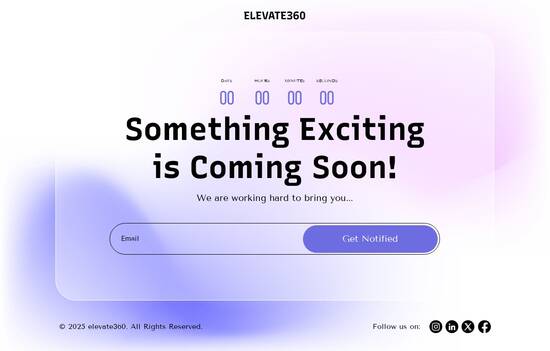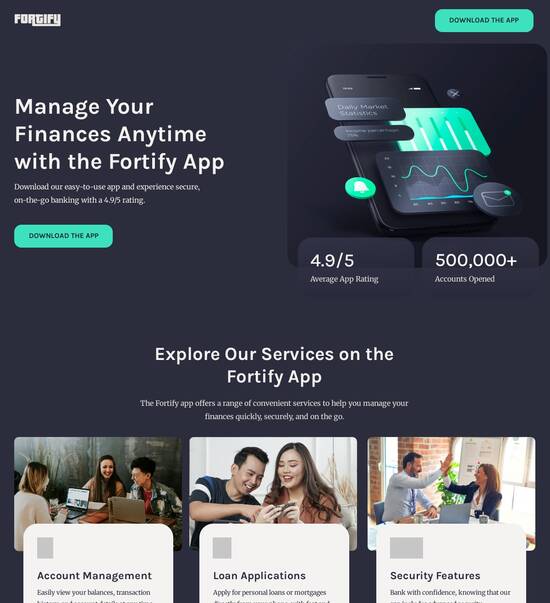
Onboarding page template for Revenue cycle managers
Explore Similar TemplatesAbout template
Master your online marketing with this builder for onboarding page template for Revenue cycle managers. Try more tools to create an immaculate landing page.
Recommended templates

Easy to build without coding
With the intuitive drag-and-drop builder, anyone on your team can create high-converting pages without any knowledge of code or design. Make enhancements to your landing page with custom widgets using Javascript, HTML/CSS, or third-party scripts.

Multiple layouts for any industry and goal
Select from 500+ landing page layouts built to boost conversions across industry-specific scenarios. Customize them by adjusting fonts, adding images, and generating on-brand content with the AI assistant. Quickly scale with Instablocks® and Global Blocks that you can save, reuse, and update globally.

Loads fast and looks polished on any device
Every template is responsive, which means they present professionally on any device and load blazingly fast with our Thor Render Engine. You can also power them up with Google AMP technology to deliver an unparalleled mobile experience and drive higher conversions.

Robust analytics & experimentation
Get real-time updates and reporting across all your devices, showing the number of visitors, conversions, cost-per-visitor, and cost-per-lead. Launch AI-powered experiments, run A/B tests, and use heatmaps to analyze user behavior, then optimize your landing page to maximize conversions.







Easy to build without coding
With the intuitive drag-and-drop builder, anyone on your team can create high-converting pages without any knowledge of code or design. Make enhancements to your landing page with custom widgets using Javascript, HTML/CSS, or third-party scripts.
Multiple layouts for any industry and goal
Select from 500+ landing page layouts built to boost conversions across industry-specific scenarios. Customize them by adjusting fonts, adding images, and generating on-brand content with the AI assistant. Quickly scale with Instablocks® and Global Blocks that you can save, reuse, and update globally.
Loads fast and looks polished on any device
Every template is responsive, which means they present professionally on any device and load blazingly fast with our Thor Render Engine.
Robust analytics & experimentation
Get real-time updates and reporting across all your devices, showing the number of visitors, conversions, cost-per-visitor, and cost-per-lead. Launch AI-powered experiments, run A/B tests, and use heatmaps to analyze user behavior, then optimize your landing page to maximize conversions.
All the features you need to build lead-generating landing pages
Explore more featuresLearn how to build top-performing landing pages for any goal
FAQs
Leading the way in building high-performing landing pages





An onboarding page template for revenue cycle managers
Revenue cycle managers play a crucial role in ensuring that healthcare providers maintain a healthy financial flow. An effective onboarding page template tailored for revenue cycle managers can streamline processes while maximizing efficiency. Instapage provides these high-converting templates that not only engage users but also encourage lead generation, ensuring a smooth onboarding experience.
Why use a specific onboarding page template?
Utilizing specialized onboarding page templates has significant advantages. First, it provides a focused approach to presenting critical information tailored to the needs of revenue cycle managers. Second, it ensures consistent branding across all communications, fostering trust. Finally, a well-structured template greatly reduces development time, allowing teams to launch quickly and respond to market demands effectively.
- Customization Options: Templates allow for specific features such as real-time data integration, enabling seamless updates.
- User Engagement: Tailored designs help in retaining user attention throughout the onboarding process.
- Data Tracking Capabilities: Advanced analytics within Instapage allow for assessment of user interaction, leading to improved future iterations.
Step one: Define your goals
The first step in creating an onboarding page template for revenue cycle managers involves clearly defining the goals you wish to achieve. This sets the tone for your content and design elements. For instance, you might want to improve user retention rates or minimize onboarding time.
Step two: Choose the right template
Selecting the right template is vital. You can benefit from Instapage’s library of over 100 high-converting templates designed explicitly for healthcare and financial services. Consider the following:
- Responsive Design: Ensure your template works across various devices, essential for today’s users.
- Lead Generation Elements: Choose templates that include forms and call-to-action buttons for capturing leads.
- Data-Driven Insights: Pick a template that incorporates analytics tools for optimizing your onboarding page.
Step three: Optimize for your audience
Once your template is selected, optimize your content for your target audience. The revenue cycle managers’ challenges and needs should guide your content creation. This may include:
- Dynamic Text Replacement: Allow for personalized experiences based on specific user characteristics.
- Visual Aids: Integrate infographics and visuals that convey complex information effectively.
- Feedback Mechanisms: Incorporate ways for users to provide feedback on their onboarding experience, helping in future enhancements.
By following these steps, you can create an onboarding page template that not only welcomes revenue cycle managers effectively but also drives measurable results.
Start creating your effective onboarding page template today with Instapage’s vast array of customizable options. Accelerate your onboarding processes and enhance user experiences now!
People also ask about Onboarding page template for Revenue cycle managers
Onboarding page template for revenue cycle managers
Understanding the onboarding page template for revenue cycle managers
Revenue cycle management (RCM) is pivotal in the healthcare finance ecosystem. It encompasses the whole process of managing claims processing, payment, and revenue generation. Understanding the process is crucial for organizations aiming to optimize their financial performance. Revenue cycle managers play a vital role in ensuring the intricate mechanisms of RCM function smoothly. They are responsible for overseeing the entire cycle, from patient registration to final payment, ensuring healthcare providers are adequately compensated for their services.
Defining key RCM terms and concepts.
Identifying the primary responsibilities which include billing, coding, and compliance.
Highlighting the importance of effective onboarding for revenue cycle managers.
Effective onboarding processes are essential as they equip new revenue cycle managers with the tools, knowledge, and connections needed to succeed. Without an organized approach, new hires may struggle to build confidence or comprehend the complex nature of RCM systems. An onboarding page template is designed to address these challenges, thus improving the overall experience and efficiency of the onboarding process.
Purpose of an onboarding page template
The onboarding page template serves several crucial purposes in the realm of revenue cycle management. Firstly, it streamlines the onboarding process for new revenue cycle managers, ensuring a consistent flow of information and resources. This not only mitigates confusion but also allows new hires to quickly gain familiarity with the expectations and responsibilities they will undertake in their roles.
Secondly, a well-structured onboarding page enhances user experience and accessibility. New managers can easily navigate through the resources, find relevant documentation, and attend training sessions at their convenience. This digital-friendly approach eliminates unnecessary delays and promotes a proactive learning environment. Besides that, having a structured onboarding process in place presents long-term benefits — fostering retention, peak productivity, and improved employee satisfaction.
Key features of the onboarding page template
An effective onboarding page template will be rich in features that cater specifically to revenue cycle managers. Foremost among these are the user interface (UI) and user experience (UX) elements. A clean and intuitive design is crucial; it should be easy to navigate and tailored for those who specialize in revenue cycle management. The design needs to be responsive, ensuring accessibility across various devices and browsers. Additionally, the use of visual aids like flowcharts, Gantt charts, and organizational charts can significantly enhance comprehension, making complex processes easier to digest for new hires.
Moreover, integrating JavaScript for interactivity can elevate the onboarding experience further. This includes the use of interactive forms that enable quick access to essential information. By incorporating dynamic dashboards, new managers can visualize data and reporting metrics that will help them understand operational performance at a glance. Lastly, the addition of AI-powered tools is becoming a game-changer for enhanced learning. They offer personalized experiences based on individual learning styles, while AI-driven insights can inform new hires about their performance and compliance requirements.
Intuitive UI design specific to revenue cycle tasks.
Responsive access for various devices and browsers.
Interactive forms for immediate information retrieval.
Dynamic dashboards for visual reporting.
AI tools to tailor learning and provide insights.
Benefits of implementing the onboarding page template
Implementing an onboarding page template offers noteworthy benefits that not only enhance the onboarding experience but also contribute to organizational efficiency. Firstly, a streamlined onboarding process leads to quicker ramp-up times. When new revenue cycle managers have a roadmap laid out before them, they can immediately begin contributing to the organization’s goals. Professional roadmap management tools found within the template aid in tracking progress and maintaining accountability among team members.
In addition, the onboarding page template supports business model and financial planning. When integrated with budgeting tools, it assists managers in smarter financial decision-making — an essential capability in RCM. Furthermore, aligning these tools with marketing plans ensures a cohesive strategy that enriches revenue cycle aims. The facilitation of digital transformation cannot be overlooked. As organizations navigate this transition, the onboarding page acts as a bridge between human resources and operations, reinforcing the need for digital marketing proficiency in today’s fast-paced environment.
Utilizing data and reports for continuous improvement
Data plays a critical role in driving successful revenue cycle management. The onboarding template should allow easy data integration and accessibility to ensure new hires can readily analyze performance metrics. This insight into the onboarding journey not only highlights efficiency areas but can also help in adjusting processes based on actual performance data. Moreover, gathering and analyzing data from the onboarding process can offer invaluable insights that help refine future onboarding initiatives.
Regular reporting and feedback mechanisms are vital for the continuous improvement of onboarding processes. Establishing feedback loops creates a business case for constant refinement of the onboarding experience. Utilizing reports to measure effectiveness helps organizations identify areas in need of improvement and enhances the overall onboarding experience for future hires.
Integrating relevant data sources for performance tracking.
Continuous data analysis for actionable insights.
Creating regular reporting schedules for transparency.
Facilitating collaboration among stakeholders
Effective collaboration among stakeholders is essential for the successful onboarding of revenue cycle managers. Engaging cross-functional teams fosters a culture of teamwork among finance, medical business, and project management professionals. Strategies for effective communication include regular team meetings, digital collaboration platforms, and clearly shared goals that encourage resource sharing. When stakeholders are involved early, they can provide new hires with essential insights that smoothen the transition into their roles.
Moreover, establishing a culture of acknowledgment and accountability is fundamental. Recognizing contributions enhances motivation within the team while fostering a sense of belonging. Clearly defining roles within the onboarding template allows managers to understand their responsibilities upfront, which enhances accountability and allows for smoother collaborative efforts across functional areas.
Engaging diverse teams during the onboarding experience.
Using collaboration tools to enhance communication.
Defining roles within the onboarding process.
Case studies and success stories
Examining real-world stories from management companies that have implemented onboarding page templates can provide valuable insights. These implementations often demonstrate how structured onboarding processes can enhance new hires’ performance and integration into the company culture. For instance, a renowned healthcare management firm saw a marked improvement in onboarding times and employee satisfaction ratings after instituting a tailored onboarding template.
The impact of onboarding templates is not limited to established companies; startups have equally reaped the rewards. By analyzing onboarding processes in diverse organizational contexts, we can draw lessons for continuous improvement. This comparative analysis offers best practices that organizations can adapt to suit their own unique contexts, ultimately achieving greater operational efficiency.
Real-world examples of successful implementations.
Comparative analysis of methods used by different entities.
Best practices identified for enhanced onboarding effectiveness.
Navigating future trends in onboarding and revenue cycle management
Emerging technologies are reshaping how onboarding processes are executed, particularly within revenue cycle management. Cybersecurity will become increasingly crucial as sensitive data continues to be at risk during onboarding. Organizations must prioritize protecting this data while also fostering compliance with regulations. Looking ahead, the role of artificial intelligence in revenue cycle management is set to expand, with predictions suggesting it could handle significant portions of RCM tasks, providing insights, monitoring performance, and uncovering anomalies.
The adaptability of onboarding templates will be key in accommodating evolving market demands. Businesses must maintain flexibility in their onboarding processes to respond effectively to industry shifts and workforce needs. Digital marketing trends that influence revenue cycle strategies require an agile approach that aligns onboarding initiatives with brand objectives and market positioning.
Prioritizing cybersecurity during onboarding.
Adaptable onboarding to meet evolving demands.
Integrating digital marketing trends in onboarding strategy.
Practical guidance for effective onboarding
Creating a tailored onboarding agenda is vital for maximizing effectiveness. The steps to develop a comprehensive onboarding plan should include defining specific objectives, identifying training resources, and outlining support systems. It’s essential to include elements like scheduled training sessions and scheduled check-ins to ensure that new hires receive continuous feedback during their transition period.
Another focus area is on best practices for maximizing user engagement throughout the onboarding process. Techniques for fostering an engaging onboarding experience are paramount. This might involve interactive training tools, opportunities for collaborative projects, and allowing new hires to participate actively in team discussions. Significantly, follow-up feedback and iterative improvements based on newly acquired insights create enhancements that could refine the overall onboarding process.
Defining clear onboarding objectives and resources.
Incorporating interactive tools and collaboration opportunities.
Establishing feedback loops for continual refinement.
Ready to skyrocket conversions?
Supercharge your ad campaigns with high-performing landing pages
Get started














